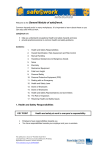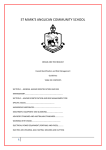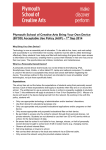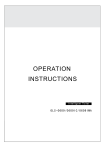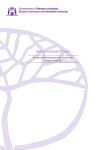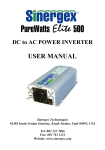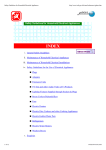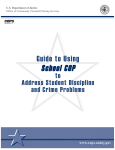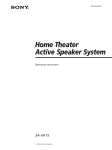Download Health and Community Services Module
Transcript
Welcome to the safe@work Health and Community Services Module. Have you read the General Module, completed the test and printed your safe@work General Award of Attainment? The Health and Community Services Module should be done AFTER the General Module. If it is some time since you have done the General Module, you should read the Review Module. The test for this module contains some questions based on the Review Module. There are common hazards that exist in the health and community services industry. It is important to learn about these hazards and how they can be controlled so that people at work are not exposed to risk. The Health and Community Services Module contains information on: • Manual Handling • Transmission of Disease • HIV/AIDS, Hepatitis B and C • Hazardous Substances and Dangerous Goods • Work Related Stress and • Violence and Bullying at Work. Within the health and community services industry you may be involved in a range of work activities such as child care; safety and first aid for children; caring for the sick and elderly and for people with disabilities and special needs; cleaning and clerical tasks. Your employer must make sure your health and safety is not harmed in any way. It is important that you work safely and follow work procedures, not only for your own safety, but also for the safety of others. Manual Handling Writing, typing, moving and placing boxes and other items on shelves, lifting, moving and carrying children: these are just some examples of manual handling tasks you may have to do in the health and community services industry. Key Point People who sustain a manual handling injury at work can spend the rest of their lives coping with pain, and be unable to do a lot of things other people can do. Many manual handling injuries in health and community services - back injuries in particular - occur as a result of lifting sick or elderly people. Work experience students, however, should not lift elderly or sick people. This publication is based on “WorkSafe Smart Move” (copyright State of Western Australia) published by Worksafe, Department of Consumer and Employment Protection, Western Australia (www.safetyline.wa.gov.au) To reduce the risk of manual handling injury your employer should: • provide safe work procedures, instruction, training and supervision for manual handling work activities • provide mechanical lifting equipment like trolleys and hoists • make sure employees do not work long shifts • re-organise work tasks to reduce the manual handling involved, and • ensure the work place layout allows employees enough space to move and work safely. You must follow manual handling procedures, which may include: • reducing the need to stoop by not putting items on the floor that will have to be picked up later (this is double handling) • lightening loads • reducing bending, twisting and reaching movements • using team lifting • using mechanical lifting equipment (e.g. trolleys and hoists to lift people), and • wearing appropriate footwear (e.g. shoes with non-slip soles and good grip). Key Point Even though you may be young and new to the job, as a young employee you should speak up - talk to your supervisor - if you feel your job is too heavy, too difficult, too tiring or puts you at risk of injury. Slippery floors Slippery and uneven floors in a community services industry work place can be a serious hazard. To reduce the hazard of slippery floors your employer should: • make sure the floors are even, slip resistant and free from obstruction • make sure spills are cleaned immediately • make sure appropriate procedures are in place to clean floors and maintain nonslip floor properties • provide non-slip mats in problem areas (e.g. the entrance to a shower room), and • install a small ramp to avoid a step between different floor heights in doorways or shower cubicles. Transmission of Disease Within the health and community services industry, transmission of disease can be a hazard. It is important that you follow appropriate procedures to ensure your own safety and the safety of others both in the work place and the wider community. This publication is based on “WorkSafe Smart Move” (copyright State of Western Australia) published by Worksafe, Department of Consumer and Employment Protection, Western Australia (www.safetyline.wa.gov.au) Employees who have direct contact with infectious people, faecal material and blood or other body fluids are at increased risk. This includes child care employees, nurses, health care employees in hospitals and community facilities for people with disabilities and special needs, laboratory employees who process biological specimens, sewerage employees and plumbers. Employees working in areas where infectious diseases are more likely to be present, such as those where hygiene and sanitation facilities are poor, may be at a greater risk. Employees in the health and community services industry often care for people with infectious diseases and may have direct contact with blood and other body fluids. Therefore, cleanliness and hygiene are very important to prevent the risk of disease and infection spreading to employees and others. Cleanliness and hygiene Note: Students on work experience must not clean contaminated waste, or be exposed to contaminated fluids. This information is designed to give students an understanding of the hazard and some of its risk control measures. Your employer must make sure you are trained in safe work procedures for cleaning and disinfecting. This also includes using 'barriers' such as gloves. As a general rule, you should clean areas thoroughly with water and detergent, using a disposable cloth. After all visible soiling has been removed, follow work place procedures and, where appropriate, wipe over surfaces with a clean, disposable cloth saturated with hypochlorite 0.5% and allow to dry. In the event of being exposed to blood or other body fluids from a needle stick injury or a splash onto a mucous membrane, you should take the following action: • promptly wash away the blood or body fluid • encourage bleeding if there is a wound, and wash thoroughly again • use appropriate anti-bacterial wash (except for your eyes and mouth, which should be rinsed thoroughly with water), and • report the incident to your employer. Counselling may be offered to you if you have been exposed to blood or other body fluids, and you may be advised to be tested for infection. Linen soiled with blood, other body fluids or excreta should be placed in a separate bag marked for "foul" linen and then put into the usual linen bag. The hot washing method used for "foul" linen destroys infectious diseases in the linen. Standard Precautions Standard precautions are work practices that should be used at all times to reduce the risk of infection from blood and other body fluids. Standard precautions essentially involve treating all blood and other body fluids as if they are infectious. They include using good hygiene practices, using protective barriers such as gloves, and appropriately handling and disposing of sharps and other contaminated or infectious waste. This publication is based on “WorkSafe Smart Move” (copyright State of Western Australia) published by Worksafe, Department of Consumer and Employment Protection, Western Australia (www.safetyline.wa.gov.au) For transmission of blood born diseases to occur, the blood or other body fluid of an infected person must enter the body through broken skin or mucous membranes of the eyes, nose or mouth. Using standard precautions and being aware of the condition of the skin (e.g. any cuts) will reduce the risk of infection. Practical hygiene steps To ensure your safety and the safety of others, your employer should make sure you are trained to follow practical hygiene steps, such as: • washing your hands between contact with patients or residents, and before eating or drinking • wearing gloves where there may be a risk of exposure to blood or other body fluids, as gloves greatly reduce the risk of your hands being contaminated with infected fluid • washing your hands immediately after removing gloves • discarding gloves contaminated with blood or other body fluids after treating each patient or resident, and put on a new pair - wearing gloves does not prevent cross-infection • when clothing is likely to be soiled with blood or any body fluid, wearing a waterproof apron or gown • wearing a mask and protective eye wear in situations where your eyes, nose or mouth are likely to be exposed to splashed or sprayed blood or other body fluid, e.g. dental and surgical procedures and cleaning soiled equipment, and • cover cuts or abrasions on exposed parts of the body with waterproof dressings at all times while on duty. Key Point Your employer must provide suitable personal protective equipment and clothing, such as gloves, face masks, safety glasses, aprons and gowns, and train you in how to correctly store and use it. HIV/AIDS, Hepatitis B and C The Health (Infectious Diseases) Regulations 2001 require all cases of notifiable infectious diseases to be reported to the Department of Human Services. This includes HIV infection, AIDS and tuberculosis. The Department of Human Services is responsible for initiating the control procedures for infectious diseases. Policies on HIV/AIDS infection are developed by the Department. Employees who have tested positive for AIDS antibodies and are healthy do not need to be excluded from their normal duties, with two exceptions: as with others suffering from an infectious disease, they should not participate in training for the administration of mouth-to-mouth resuscitation, and they should not care for patients who have any disease that affects the immune system. These exceptions are because of the risk of transmitting infections to these patients. This publication is based on “WorkSafe Smart Move” (copyright State of Western Australia) published by Worksafe, Department of Consumer and Employment Protection, Western Australia (www.safetyline.wa.gov.au) Your employer must make sure employees who have tested positive for Hepatitis B and C or HIV/AIDS follow some general precautions to prevent the transmission of the disease. This includes: • not donating blood • covering any cuts or abrasions with a waterproof dressing • wearing gloves when dealing with patients if skin is broken • washing hands thoroughly after contact with their own blood or other body fluids • not sharing personal items such as razors and toothbrushes, and • having regular follow-up medical assessments (in the case of HIV/AIDS). There is no likelihood of catching HIV/AIDS or Hepatitis B or C from casual contact at work. As Hepatitis B and C and HIV/AIDS are blood borne diseases, it is not necessary for the employer to be informed that the employee is infected, unless warranted by their particular situation, e.g. doctors and dentists where the risk of infection is increased due to contact with body fluids. Understanding, open communication, support and assistance are needed. Hazardous Substances and Dangerous Goods In the health and community services industry, employees may use and handle hazardous substances and dangerous goods such as cleaning products, detergents, disinfectants, medical supplies and medical waste. Note: Students on work experience must not clean contaminated waste. Chemicals and hazardous substances in the work place need not be dangerous if used safely. Awareness of possible risks, even from ordinary substances, can help prevent sickness, discomfort and injury. It is important that your supervisor makes sure you use hazardous substances and dangerous goods according to the manufacturers or supplier's written instructions (the Material Safety Data Sheet or MSDS) and the agreed safe work procedures for your work place. If you need more information on the substances that you are using, ask your supervisor or health and safety representative. To reduce risk, your employer can sometimes substitute a non-hazardous cleaning product. You may need to wear gloves when handling and using some chemical cleaning products. Your employer must provide protective gloves. This publication is based on “WorkSafe Smart Move” (copyright State of Western Australia) published by Worksafe, Department of Consumer and Employment Protection, Western Australia (www.safetyline.wa.gov.au) Medical waste Employers must make sure medical waste is handled safely. Safe work procedures include the following: • medical waste should be stored in a weather-proof, secure location, isolated from other wastes and in a safe manner, so that it does not pose a hazard to people or the environment • sharps (objects or devices having sharp points capable of cutting or piercing the skin) should be placed in a suitable container that is puncture resistant, leakproof, clearly coloured, labelled and capable of being sealed when full. It should also carry the biohazard symbol recognised worldwide and adopted for use in Australia. Caution, biological hazard Biological hazard • medical waste should be stored in a clean, leak-proof, clearly labelled container suitable for transport to a disposal site • biological specimens should be incinerated • people responsible for collecting medical waste must be authorised by the Department of Human Services • pharmaceutical products should be disposed of as for medical waste, and • reusable containers should be thoroughly cleaned prior to use. Work Related Stress Stress is often part of work in the health and community services industry, because employees may often deal with sick, elderly, and injured people on a daily basis. Examples of stressful work you may have to do include jobs that involve: • dealing with violent and aggressive behaviour or the threat of it occurring • dealing with injury, disease and death, and • having continuous contact with people and human suffering. Occupational stress is people's natural reaction to being put under intense pressure at work over a period of time. It is reasonable for your employer to assume that you are mentally capable of withstanding some degree of pressure from normal work demands. However, individual circumstances at different times may mean you are more at risk of becoming stressed. This publication is based on “WorkSafe Smart Move” (copyright State of Western Australia) published by Worksafe, Department of Consumer and Employment Protection, Western Australia (www.safetyline.wa.gov.au) Stress can be started or made worse by work arrangements, deadlines and demands set without consultation, conflict, bullying and harassment. Personal problems at home, or a death or illness in the family will also influence your capacity to cope with stress at work. Stress is not a disease or injury, but it may cause your work performance to drop and your health to decline. The effects of stress can be both physical and behavioural. Generally these effects last only briefly and have little or no long term effects. Physical effects may include increased heart rate, headache, blurred vision, perspiration, dizziness, aching neck and shoulder muscles, clenched jaw and skin rashes. Behavioural effects sometimes include increased anxiety and irritability. "flying off the handle" easily, excess alcohol and other drug taking, poor sleeping, impaired concentration, and even nervous breakdown. Not all pressure is harmful. People are often kept motivated by the challenges and difficulties we meet and are able to solve at work. However, the ability to deal with pressures is not limitless. Preventing Stress To reduce or remove unnecessary stress, employers can: • provide a consistent approach to management • encourage supervisors and employees to talk about any problems or concerns • provide well-defined tasks with clear responsibilities • provide relief if the job is very monotonous or boring • set challenging but achievable targets • use flexible work schedules that are planned and agreed • make sure that people are treated fairly and without bullying or harassment, and • provide positive feedback when appropriate. There will always be times at work when you feel more stressed than usual. Talking to others about your concerns often eases the pressure. Keeping fit and healthy will help you deal with a crisis better. Violence and Bullying at Work In the health and community services industry, you may be at risk of injury or harm from violent and bullying acts. You may have to work with patients who are confused or unwell, and who may be prone to violent outbursts or aggressive acts. Non-physical violence such as verbal abuse, intimidation and threatening behaviour may cause you to feel stressed. Your employer must take steps to protect you from violence at work. Talk to your supervisor if you feel threatened or are not sure how to deal with violent or aggressive persons at work. This publication is based on “WorkSafe Smart Move” (copyright State of Western Australia) published by Worksafe, Department of Consumer and Employment Protection, Western Australia (www.safetyline.wa.gov.au) Self-Assessment Questions Now try the self-assessment questions. Before starting the questions, be sure to enter your name and the name of the school exactly as you want it to appear on your Award of Attainment. We ask you to provide these details so that you can be issued with the Award of Attainment. There are 16 questions. If you get 12 or more correct you can print online a safe@work Award of Attainment. The Principal of your school will then sign the Award of Attainment and validate it with the school stamp. This publication is based on “WorkSafe Smart Move” (copyright State of Western Australia) published by Worksafe, Department of Consumer and Employment Protection, Western Australia (www.safetyline.wa.gov.au)









